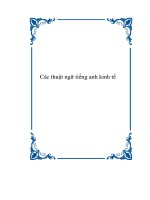Môn tiếng anh kinh tế quốc tế: INTERNATIONAL BUSINESS LETTERS (phần 1)
Bạn đang xem bản rút gọn của tài liệu. Xem và tải ngay bản đầy đủ của tài liệu tại đây (409.46 KB, 24 trang )
LOGO
INTERNATIONAL
BUSINESS LETTERS
Tran Thi Thu Trang
OBJECTIVES
After studying this part, the students
should be able to:
Have ability to understand the language of
international business letters in English.
Have ability to write some routine
international business letters in English
such as: Enquires, Replies and Quotations,
Orders, Complaints and adjustments.
QUESTIONS FOR REVIEWS
1. What are the main parts of a business letter?
2. What does the letterhead contain?
3. Where is the position of sender’s address and how do you
write them?
4. How do you write the date in a business letter?
5. What and how do you write in the complimentary closure?
6. What is the right order of writing the receiver’s address?
7. What rules do you observe when making an enquiry?
8. How do you write a routine letter of enquiry?
9. What should be included in a good quotation?
10.What are the most important items in an order?
11.What should be written in a complaint?
12.What are the most usual cases for lodging a complaint?
INTRODUCTION
Letters:
Are used in transaction such as offer.
Are required a lot of time.
Are rather secret.
Make the first impression of the company.
Structure and Presentation
Content and Style
Enquiry
Replies and Quotations
Complaints and Adjustments
Order
CONTENTS
STRUCTURE AND PRESENTATION
Two styles of letter: blocked and
indented. Blocked style is usually used.
Align text to the left.
A line space between paragraphs.
STRUCTURE AND PRESENTATION
Letterhead/Sender’s address
References
Date
Inside address/Receiver’s address
Special marking
Attention line
Salutation
Subject title
STRUCTURE AND PRESENTATION
Body of the letter
Complimentary close
Name of sender
p.p/for
Job title
Enclosure
Copy
STRUCTURE AND PRESENTATION
Letterhead includes:
• Logo
• Name: shows the type of company (Ltd., PLC, Inc.,
Co.)
• Address
• Fax, telephone, email, website
• Account number/VAT number
Sender’s address: is written on the top right-hand side
of the page if the page doesn’t have a printed
letterhead.
STRUCTURE AND PRESENTATION
References: may be the initial of writer/typist; or file
reference; or the date; or the department.
To help to find a file in the company easily.
Eg: Shirley Taylor – writer
Pradeep Jethi – typist
Ref: ST/PJ
Date: is written on the right-hand side of the page.
Eg: day/month/year (B.E)
29 September 2011
month/day/year (A.E)
September 29
th
2011
STRUCTURE AND PRESENTATION
Inside address/receiver’s address: is written on the
left-hand side of the page.
• Name of receiver: Title (Mr/Miss/Mrs/Ms) + full
name
• Job title
• Company of receiver
• Full address
• Postal code
Special marking: urgent, private, confidential…is
written in capital letter if important.
Attention line: If inside address doesn’t have name of
receiver, an attention line will be used.
STRUCTURE AND PRESENTATION
Salutation:
• A company: Dear Sirs (B.E), Gentlemen (A.E)
• A person if don’t know the name: Dear Sir, Dear
Madam, Dear Sir or Madam.
• A person if know the name: Dear + title + surname.
Subject title: less than 10 words about the topic of the
letter.
STRUCTURE AND PRESENTATION
Body of the letter: a line space between paragraphs.
Complimentary close:
• Yours faithfully: Dear Sir, Dear Madam, Dear Sirs.
• Yours sincerely: Dear Mr. Smith
• Yours truly/Truly yours: A.E
Name of sender: full name with title after your
signature.
p.p/for: For and on behalf of
STRUCTURE AND PRESENTATION
Job title
Enc. (Enclosure): attached enclosures with number of
documents.
Eg: Bill of lading (5 copies)
Bill of exchange (1 copy)
c.c (carbon copies): Copies are sent to people other
than the named recipient.
b.c.c (blind carbon copies): the named recipient will
not know the other receivers. (email)
STRUCTURE AND PRESENTATION
Note:
• Envelope Addresses : are similar to inside addresses.
Remember to write postcode and the name of both the
town and the country in capital letters.
• Continuation page:
o No letterhead
o Page number + Reference + Date + Inside address.
CONTENT AND STYLE
How to write business letter
How much information to give
How to plan your letter
What sort of style to use
CONTENT AND STYLE
Length
Order and sequence
Planning your letter
Style and language
CONTENT AND STYLE
Length:
• Length depends on the subject of the letter.
• The letter should be neither too long nor too short.
• Too much information is better than too little.
CONTENT AND STYLE
Order and sequence:
• Each idea is linked up with the previous one in a
pattern.
• Do not jump around making a statement, switching
to other subjects, then referring back to the point
you made a few sentences or paragraphs before.
CONTENT AND STYLE
Planning your letter:
• Ask yourself: what do you want your letter to
achieve and what response do you want?
• Note down everything you want to include in it
before you start writing.
• Review to see (a) that you have included all the
necessary information, (b) that you haven’t included
any unnecessary information, and (c) that you have
put the information in the right order.
CONTENT AND STYLE
Planning your letter:
• First paragraph: you will introduce your company,
thank for your partner’s letter and set out the purpose
of the letter.
• Middle paragraph: you will give details (facts and
figures) and response and action.
• Final paragraph: thank the person for writing,
encourage further correspondence and mention that
you look forward to hearing from your partner soon.
CONTENT AND STYLE
Style and language:
• Simplicity: easy to write and read.
• Courtesy: the letter will be polite with complex
sentences, conjunctions,…
• Idioms and colloquial language: should not be used.
CONTENT AND STYLE
Note:
• Abbreviations can be used if both parties know what
the abbreviations stand for.
Eg: FOB, CIF, IMF, WB…
• Figures: can cause confusion. Therefore, write out
the expression in both figures and words.
Eg: the different usage among countries: decimal
point with a full point and a comma.
CONTENT AND STYLE
Note:
• Check carefully spelling, punctuation and grammar
before sending the letter.
• Enclosed the right documents that you have
mentioned in the letter.






